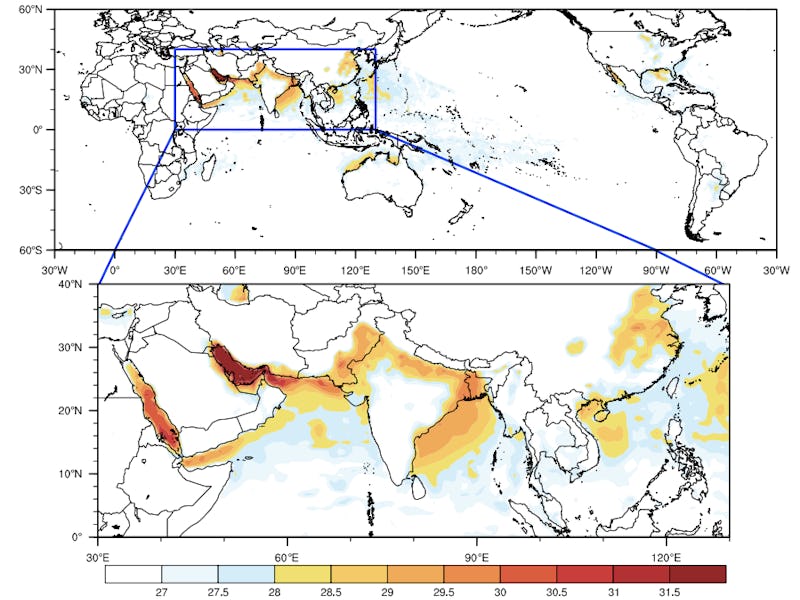People in These Regions Will Face 'Unsurvivable' Heat by 2100
Humans can't live at wet-bulb temperatures of 95 degrees for long.

In the future, parts of the world will become so hot and humid that healthy adults sitting in the shade will die within a matter of hours. It’s hard to imagine, and yet that’s where Earth’s climate is headed, perhaps sooner than expected.
New research, published Wednesday in Science Advances, found that 75 percent of the population of South Asia will experience extremely dangerous heat waves by 2100 if no action is taken to fight climate change. Four percent will experience unsurvivable heat — that’s 69 million people at today’s population level.
The Indus and Ganges river valleys, spanning southeast Pakistan, northern India, and Bangladesh, have a disastrous combination of a densely populated, vulnerable population and extreme, humid heat. In these parts of the world, extreme heat is already frequent and deadly. A 2015 heat wave that covered large parts of India and Pakistan killed an estimated 3,500 people.
These are the highest recorded wet-bulb temperatures through 2015 in degrees Celsius.
While most climate change studies look only at temperature, this one uses a different measure that accounts for the impact of humidity on the ability of humans to cool themselves off through sweating. It’s called wet-bulb temperature, and it measures how hot the air would be if cooled through the evaporation of water until it reaches 100 percent humidity.
When humans sweat, that moisture evaporates into the air, which transfers heat energy away from the skin. However, when the wet-bulb temperature reaches the temperature of the skin, at about 95 degrees Fahrenheit, it becomes impossible for heat to move away from the body in this way. Even if enough sweat could be produced to bring the surrounding air to 100 percent humidity, the air would still be hotter than the skin, and no energy would leave the body. Previous research has estimated that a healthy human could survive a maximum of six hours in these conditions — which means find a cooler spot, or die.
A wet-bulb temperature of 95 degrees has never been recorded, but parts of the world have hit 89 degrees, which is already extremely dangerous to any human who is exposed to it for more than a short period of time. The hottest wet-bulb temperatures in the world are found in the Persian/Arabian Gulf, in the northern parts of South Asia, and in Eastern China.
This study focused on South Asia — defined as the countries of Pakistan, Indian, Bangladesh, Nepal, and Sri Lanka — because here there is a coincidence of very high wet-bulb temperatures and a dense population of relatively poor, rural people. That makes this the most vulnerable part of the world to future deadly heat waves.
Maps show wet-bulb temperature maximums in Celsius in the historical record (B); and projected to 2100 under aggressive climate change action (C); and limited climate action (D). At 35 degrees, humans can only survive a few hours.
If there’s a glimmer of hope, it’s that the researchers found a very significant difference in outcome if the world bands together to aggressively fight climate change. With concerted action to limit greenhouse gas emissions, none of South Asia would surpass the unsurvivable threshold by 2100, although 55 percent of the population would still be exposed to extreme wet-bulb temperatures of 88 degrees or higher.
In any case, humans living in very hot and humid parts of the world will be forced to adapt. That will mean air conditioners for those who can afford it and, likely, communal cool spaces for emergencies. At the most extreme, we may see mass migrations of climate change refugees away from regions of the world that have become literally unsurvivable.
Abstract
The risk associated with any climate change impact reflects intensity of natural hazard and level of human vulnerability. Previous work has shown that a wet-bulb temperature of 35°C can be considered an upper limit on human survivability. On the basis of an ensemble of high-resolution climate change simulations, we project that extremes of wet-bulb temperature in South Asia are likely to approach and, in a few locations, exceed this critical threshold by the late 21st century under the business-as-usual scenario of future greenhouse gas emissions. The most intense hazard from extreme future heat waves is concentrated around densely populated agricultural regions of the Ganges and Indus river basins. Climate change, without mitigation, presents a serious and unique risk in South Asia, a region inhabited by about one-fifth of the global human population, due to an unprecedented combination of severe natural hazard and acute vulnerability.